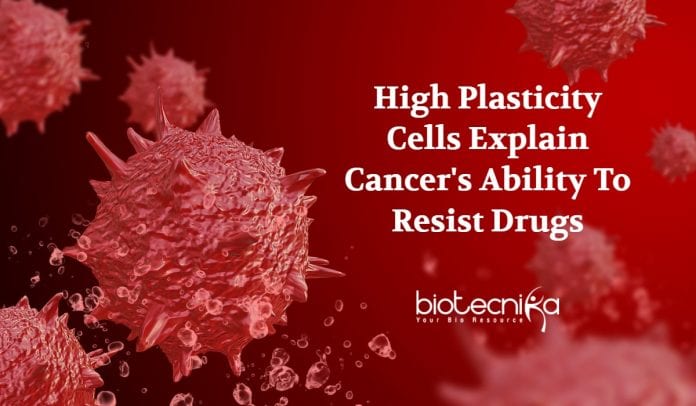Chemotherapy Resistance In Cancer Could Be Due To High Plasticity Cells
In achieving lasting remissions or cancer cures, cancer’s tendency for developing resistance to chemotherapy has always been an obstacle. Many times, the tumors that shrank during chemotherapy eventually grow back.
Scientists once believed that unique genetic mutations render the tumors this resistance for chemotherapy. But to explain their adaptability, scientists started looking at the nongenetic changes in cancer. Changing identity is one strategy of cancer cells to develop resistance. For example, a prostate cancer cell that is sensitive to hormone-blocking therapy turns to a cell that no longer requires hormone for its growth.
Changes in gene expression ( turning specific genes on or off) drive them to identify changes, rather than genetic mutations. Since it is unlikely that a single drug work against so many different cell types, this heterogeneity creates challenges for treatment.
A group of researchers at the Koch Institute for Integrative Cancer Research at MIT, the Klarman Cell Observatory at the Broad Institute and the Sloan Kettering Institute found that this heterogeneity in tumors can be traced to a common source, a specific flexible cell state.
Tuomas Tammela, an Assistant Member in the Cancer Biology and
Genetics Program at SKI, said the tumor heterogeneity starts from this high-plasticity cell state. The state is an intersection through which the cell has to pass wherever it wants to end up identity-wise.This is an interesting target for potential cancer therapies as this cell state produces nearly all the cellular heterogeneity that emerges in tumors.
The researchers investigated lung cancer tumors growing in mice for this study published in the journal Cancer Cell on July 23. The scientists were first surprised to see the highly plastic state, and they didn’t know what it was as it looked really different. The cells didn’t look like lung cancer nor lung cells. They were more like embryonic germ layer stem cells, kidney cells, and cartilage stem cells combined. And scientists found this kind of cell in every tumor they examined, suggesting that they have some crucial role to play in offering chemotherapy resistance in cancer.
A relatively new technique called single-cell RNA sequencing (scRNA-Seq) was used by researchers to identify these highly plastic cells. The individual cells’ gene expression profiles can be studied using this technique, revealing which genes are off or on. They saw how different cell types emerged over the course of a tumor’s evolution by performing scRNA-Seq on tumors as they grew over time. They developed a kind of map of which cells came from which other cells from these data. The high-plasticity state sits right in the middle of the map and was the only cell state found common in every single tumor.
Stem cells are known for their plasticity or the ability to give rise to cells of different identities. Several scientists think that tumors arise from specific cancer stem cells. But Dr. Tammela and the team do not think these cells with high plasticity are stem cells. The signatures of gene expression in cancer stem cells or normal stem cells did not match with that of these high-plasticity cells. And these cells are not there at the beginning of tumor growth, they emerge later, which is not the case of stem cells.
Previous studies were trying to figure out the mystery behind cancer’s resistance to drugs; most of them looked at the genetic mutations. But it remained a mystery until now with the new findings that offer a potential solution.
The study explains why certain cancer cells are resistant to chemotherapy and do not carry a genetic basis for the same. Moreover, the study clarified that not all tumor cells are adapting; high-plasticity is observed only in a subset of cancer cells. Researchers think it might be possible to avert the emergence of chemotherapy resistance in cancer and provide longer-lasting remissions by combining chemotherapy drugs with new medications that target these highly plastic cells.






























